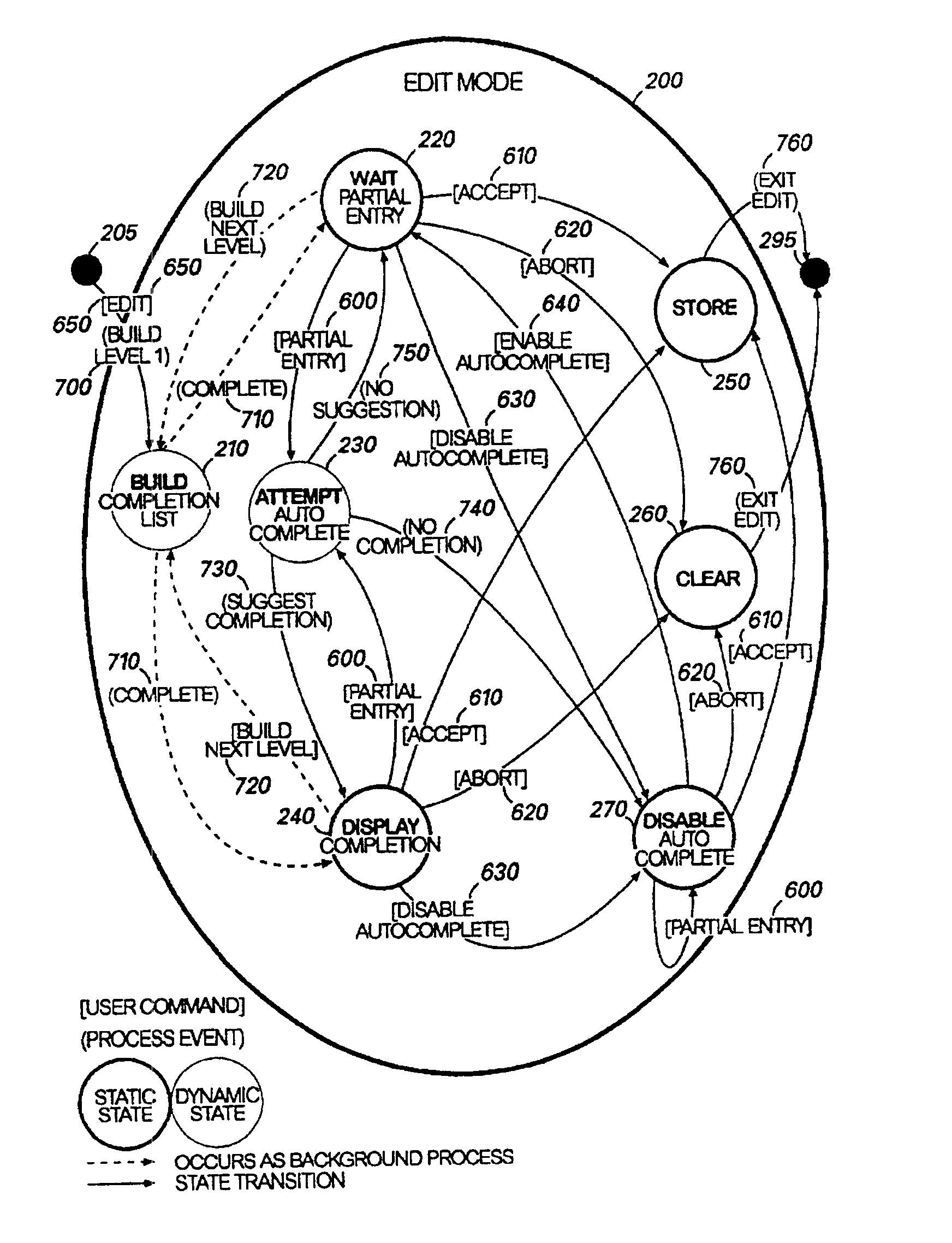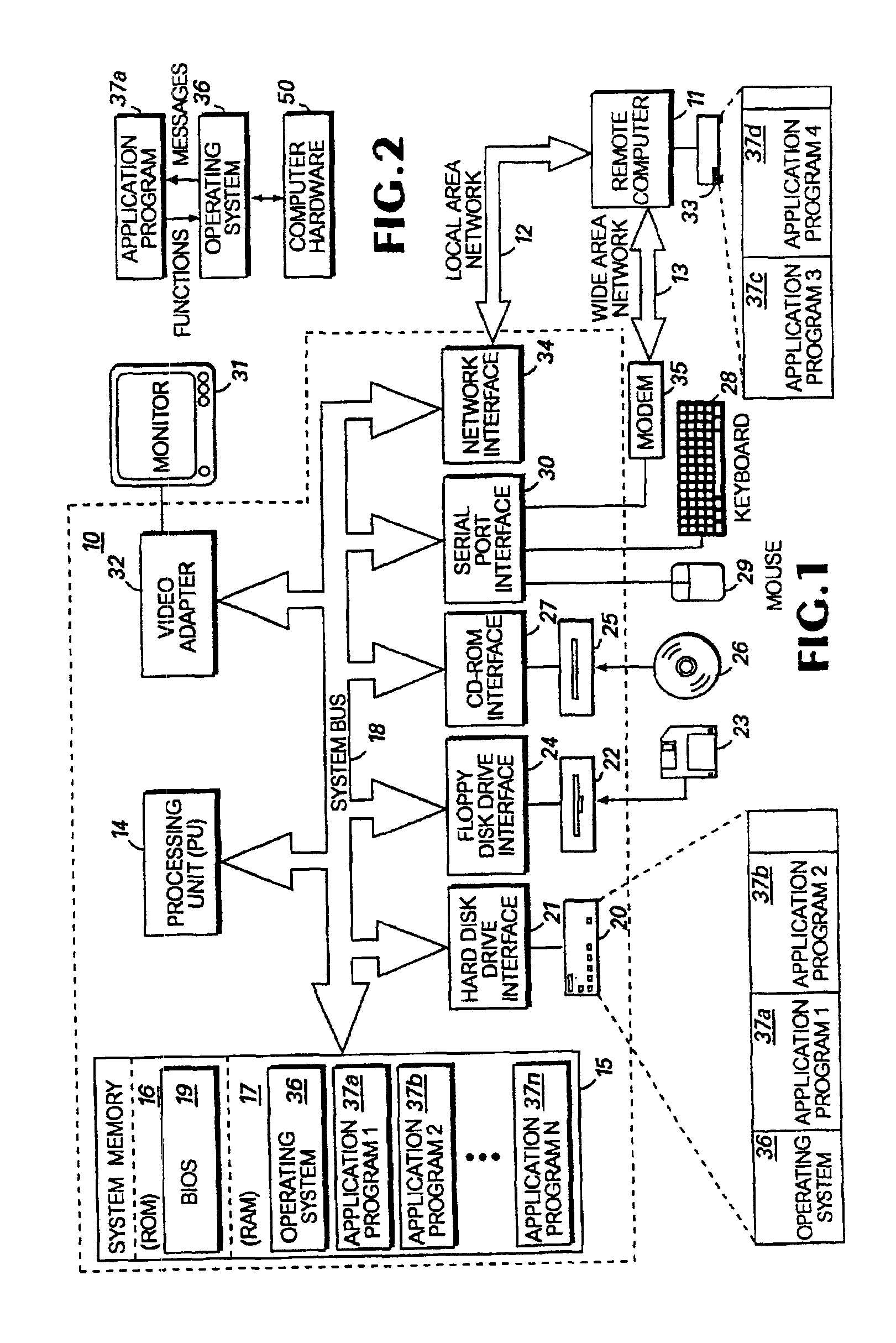[0014]A unique aspect of the
generation process includes defining which data items are associated with the data item being entered. In the context of a generic database, the present invention provides several methods to perform this process. Generally, data items that fall within the same category or a similar category to the data item being entered are considered to be associated data items. Therefore, an
advantage of the present invention is the ability to define which data entries within a database are related to a data item being entered, to generate a list of suggested completions based on these associated data entries, and to provide a dynamic completion list which tracks the actual contents of the database.
[0015]Another aspect of the present invention is that the completed data item list can be filtered so that data items which do not benefit the automatic completion feature are eliminated from the list. This is especially beneficial in a generic database where the nature of the database allows for a mixture of data types within associated categories. For instance, a generic database may allow for numeric entries and text entries to be entered into the same database category. An example of such a category would be a
library database, which combines the category that lists the name of the person a book is checked out to, and the category indicating the number of days that the book has been on the shelf without being checked out. The second category is used to determine if the book should be removed from the shelves and placed into the archives. In this
scenario, the numeric entries for the days on the shelf could be filtered from the completed data item list. The benefits derived from this ability is that the list is not encumbered with extraneous numeric entries which could result in slowing down the list
generation process, and the entry of
numeric data will not trigger any automatic completions which could easily result in entering
invalid data (i.e., having the entry “1” automatically complete to “100”). Therefore, another
advantage of the present invention is the provision of a technique for filtering out non-useful items from the list of suggested completions in order to maximize the efficiency of an automatic completion feature.
[0016]Second, the present invention minimizes the
impact of the completion lists on
system resources such as memory by storing the completed data item list in a
dynamic data structure. In contrast to a
static data item list, a dynamic list does not require permanent memory resources. Once a data item has been entered into the database and accepted by the user, the memory occupied by the data item list can be released and reallocated to other resources. The efficient use of memory resources is necessary in a database system, and thus, the minimization of overhead memory is imperative. This is increasingly important in a generic database that does not have pre-defined data types, and therefore, can not obtain the benefit of using efficient memory storage schemes which take
advantage of pre-defined data types. Advantageously, the present invention provides a list of suggested completions which makes efficient use of memory storage.
[0017]Third, the present invention minimizes any delays in
processing user inputs by using a tiered technique to generate the completed data item list. This tiered technique includes generating the completed data item list one section at a time, allowing for input
processing in between the generation of each section. In addition, a suggested completion can be provided to the user based on a partially generated list. This is beneficial because it provides virtually immediate feedback to the user and expedites the data entry process. Therefore, another benefit of the present invention is the generation of a list of suggested completions in a manner that minimizes the
impact to
data input processing and provides instantaneous responses to the user.
[0018]More specifically described, the present invention is an automatic completion feature that can be implemented in a spreadsheet application. When a user begins to edit a
cell within a spreadsheet, a completed data item list is generated from the previously entered data items stored in cells associated with the edited
cell. As the user enters characters into the
cell, the completed data item list is searched for an entry corresponding to the partial data entry in the edited cell. If a qualifying match is found, then the data item is displayed as a suggested completion within the cell being edited. The user then has opportunity to accept the suggested completion and thereby accelerate the data entry process, to enter additional characters to define a new data entry in the spreadsheet, or to reject the suggested completion. By accepting the suggested completion, the benefit of increasing the speed of data entry is realized and the integrity of the entered data is assured (i.e., the data entry is in conformance with previously entered data). Therefore, it is a further advantage of the present invention to improve the efficiency and reliability of data entry in a spreadsheet by providing the ability for an automatic completion feature utilizing a list of completed data items stored in cells associated with a cell being edited.
[0019]These and other aspects, features, and advantages of the present invention will be more clearly understood and appreciated from a review of the following detailed description of the present invention and possible embodiments thereof, and by reference to the appended drawings and claims.
 Login to View More
Login to View More  Login to View More
Login to View More 


